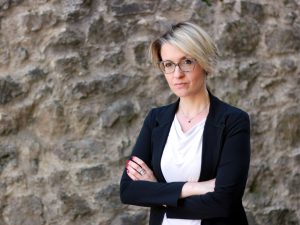Young researchers shape our future. Bringing their innovative ideas into our projects, they contribute not only to the excellence of research of the University of Luxembourg’s Interdisciplinary Centre for Security, Reliability and Trust (SnT), but also to our impact in society. They take our research to the next generation.
In this edition of the series, we feature Dr. Nadia Pocher and her research on interdisciplinary co-design of digital financial systems and central bank digital currencies (CBDCs).
Dr. Nadia Pocher, postdoctoral researcher at the Digital Financial Services and Cross-Organisational Digital Transformations research group (FINATRAX), gave us some insights into the research projects she is working on, reflected on how their interdisciplinary approach will shape the future, and shared her future plans with us.
Nadia, what are you working on in your research?
Together with Spuerkeess and as a project of the National Centre of Excellence in Research in Financial Technology (NCER-FT), we are exploring the potential of decentralised finance (DeFi), as well as the compliance and enforcement of crypto-assets. Both projects are built on strong interdisciplinary collaboration. We believe that the challenges of today and tomorrow concerning emerging technologies in finance cannot be addressed in disciplinary silos. For this reason, we think that representatives of different domains must be simultaneously involved during the design of new systems. Nowadays, we do not see this only as a strategy, but rather as a necessity. This is especially true if our goal is to provide financial products and services that enhance the competitiveness of Luxembourg.
What is the motivation for this approach?
Imagine a single person capable of designing every aspect of a complex financial system. This person would work step by step and probably achieve their design goals quite smoothly. However, designing innovative financial products and services requires the collaboration of many individuals of diverse backgrounds. It is not surprising that their individual journeys in the project may not always align. In reality, the most significant questions in FinTech – think about CBDCs, for instance – are being explored by thousands of people around the world. This is why we need to find ways to work together with methods that can unleash synergies.
What solution does your approach offer?
In our research group, we value interdisciplinarity not only in our day-to-day activities, but also by actively investigating how we can enable interdisciplinary collaboration. As an example, we critically analyse established design processes, focussing on the activities that define the design objectives. In this way, we understand if there is something we need to refine to accommodate interdisciplinary thinking. We conceptualise spaces where researchers and practitioners can jointly balance knowledge from different fields: First, we identify which disciplines are relevant for our project. Second, we explore notions and principles that may be important from the perspective of the different fields. Third, we try to understand whether we are using concepts and terms in ways that may look similar on the surface but disguise very different meanings. At this point, we can constructively balance all elements and mitigate the conflicts that may arise. This is the foundation for developing new systems in an interdisciplinary way.
How does this approach shape the future?
Let’s look at the example of retail CBDCs, like the future digital euro. These systems present us with different design options that are all based on interdisciplinary choices, making it more important than ever to remove conceptual ambiguities. This is especially true because these interdisciplinary choices manifest themselves in terms of spectra: Where will a given system be positioned in the spectrum that goes from decentralised to centralised? What is the level of end-user privacy to be accommodated in the system? To address these questions, we need to develop a common language. For instance, speaking of privacy: Are we, as computer scientists, lawyers, and economists, talking about the same thing?
What inspired you to work in research at SnT?
Toward the end of my Ph.D. on the anti-money laundering (AML) regulation of crypto-assets, I was eager to continue my research at the intersection of law and computer science. To do so, I was looking for scientific methods that would allow me to bridge the two disciplines in a sound and future-proof way. I was particularly interested in close collaborations with the financial services industry, as well as with governmental and regulatory authorities. When I found the FINATRAX vacancy for a research associate on design and innovation theories for fintech and digital assets through the lens of information systems, it became clear to me that SnT was the perfect place to pursue my interests and ambitions.
What are your future plans?
I plan to continue to bridge the gap between legal and technology experts to foster synergies and dismantle knowledge silos. Using my background, I want to contribute to increasing the recognition of interdisciplinary research and methodologies, both within academia and beyond. My goal is to devise solutions that allow society to constructively navigate innovative advances while assessing the corresponding risks. To achieve this, I will continue my research on interdisciplinary trade-offs and compliance technologies in finance, ranging from AML and data protection to artificial intelligence and crypto-asset analytics. I also plan to deepen my engagement with the financial services industry, as well as regulatory and supervisory bodies.
About Nadia: Nadia received her Ph.D. in Law, Science, and Technology, excellent cum laude, from the University of Bologna, jointly with a Ph.D. in Law from the Autonomous University of Barcelona and K.U. Leuven. Prior to this, she received her Master of Laws, summa cum laude, from the University of Trento. In her research, she focusses on the regulation and compliance of emerging technologies in the financial space.
